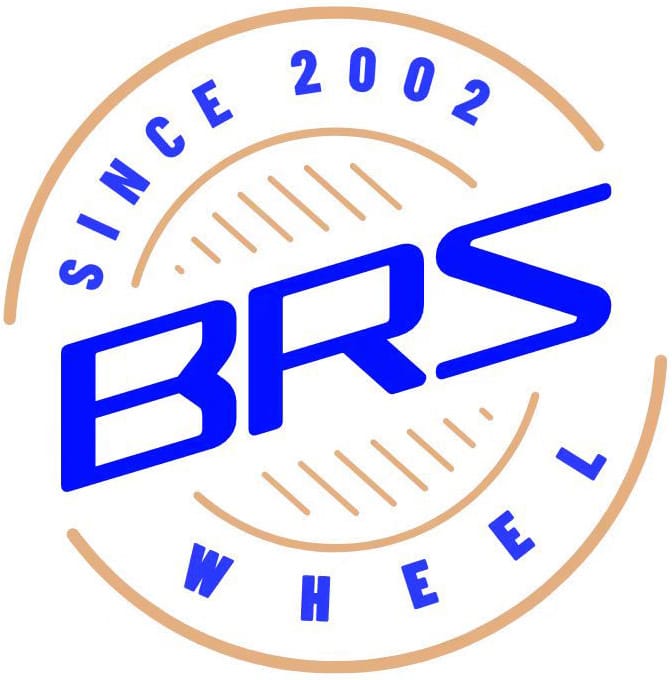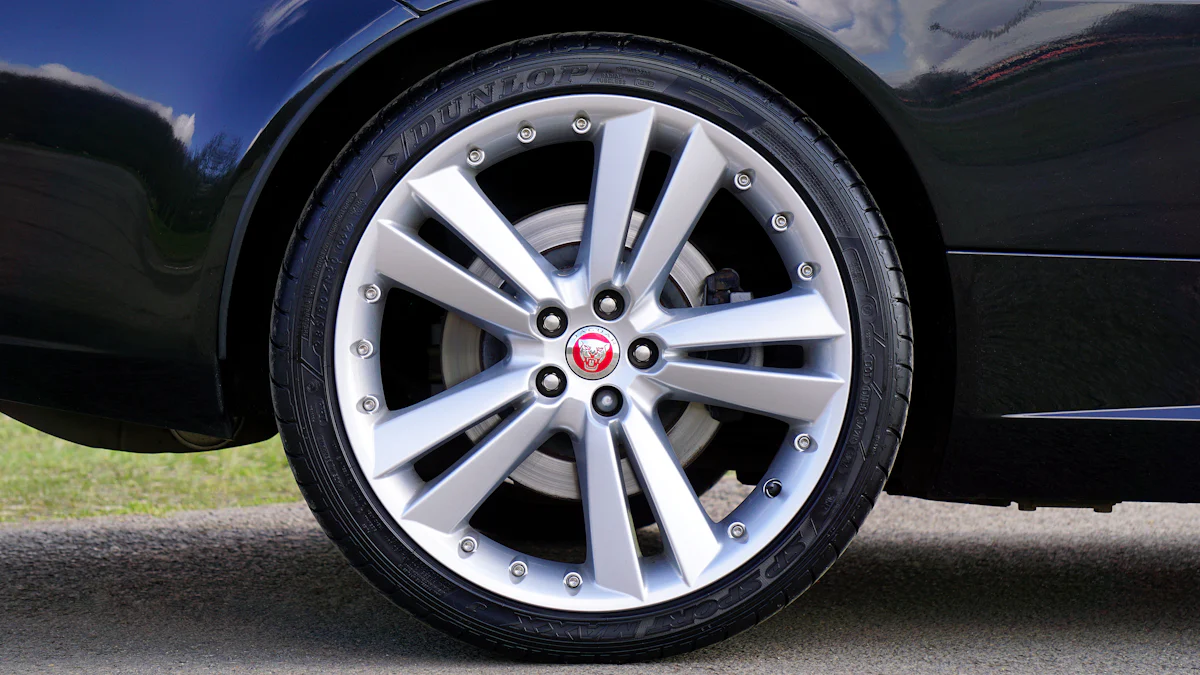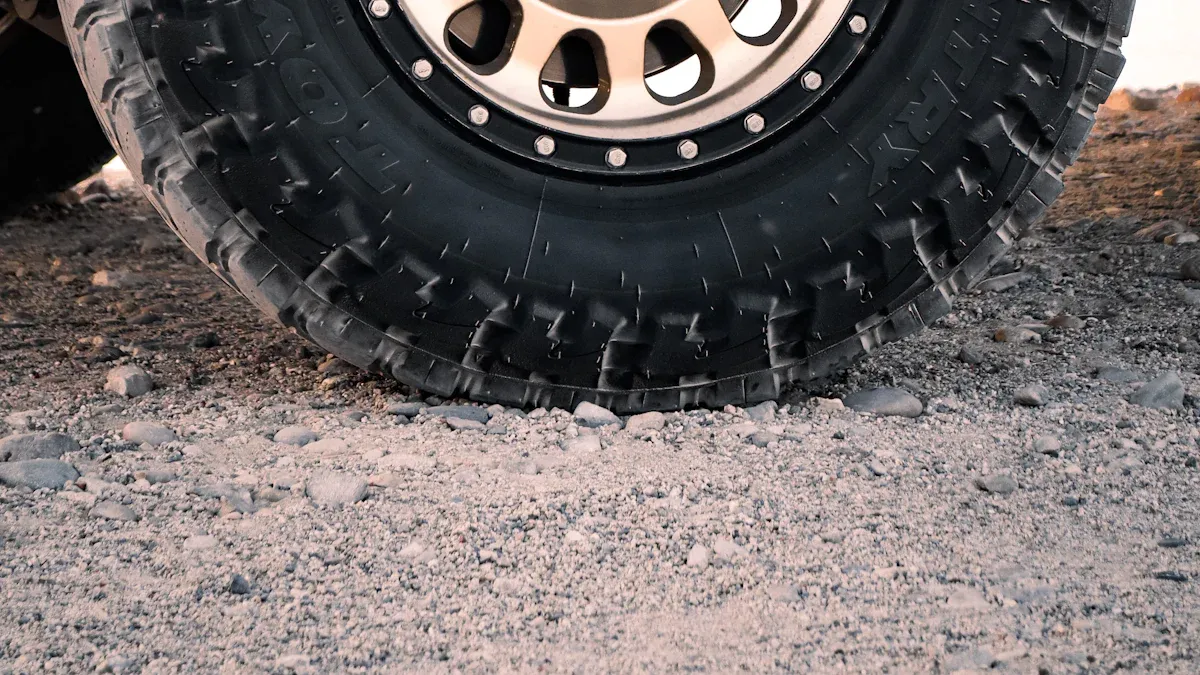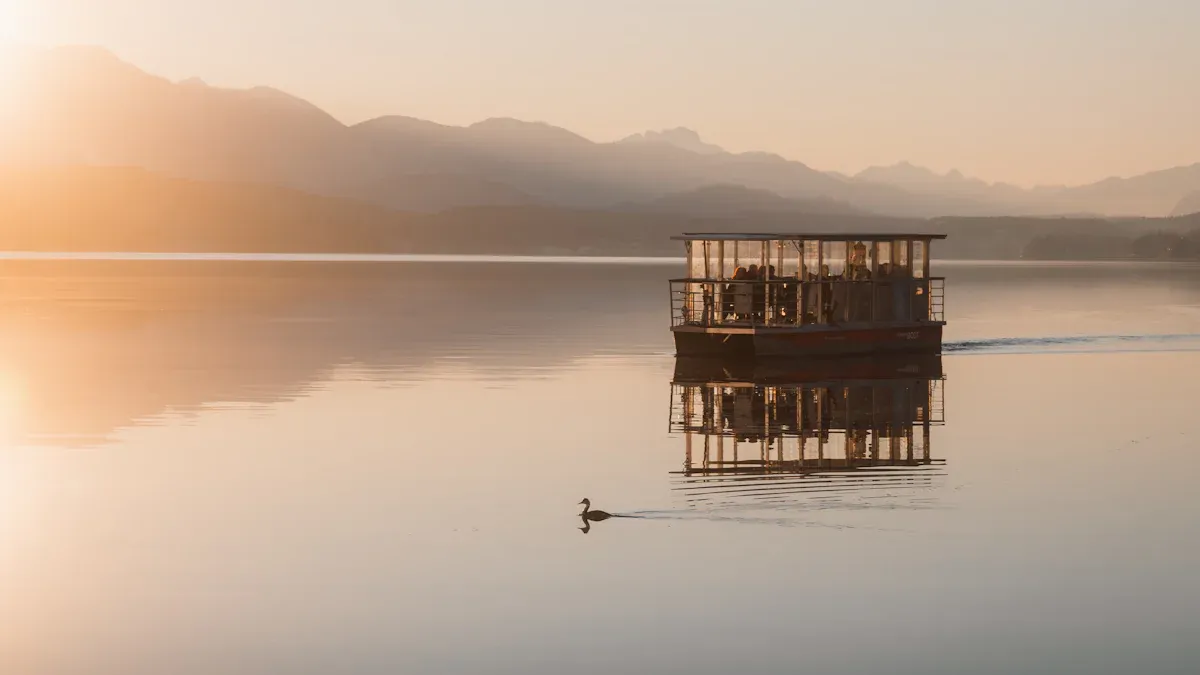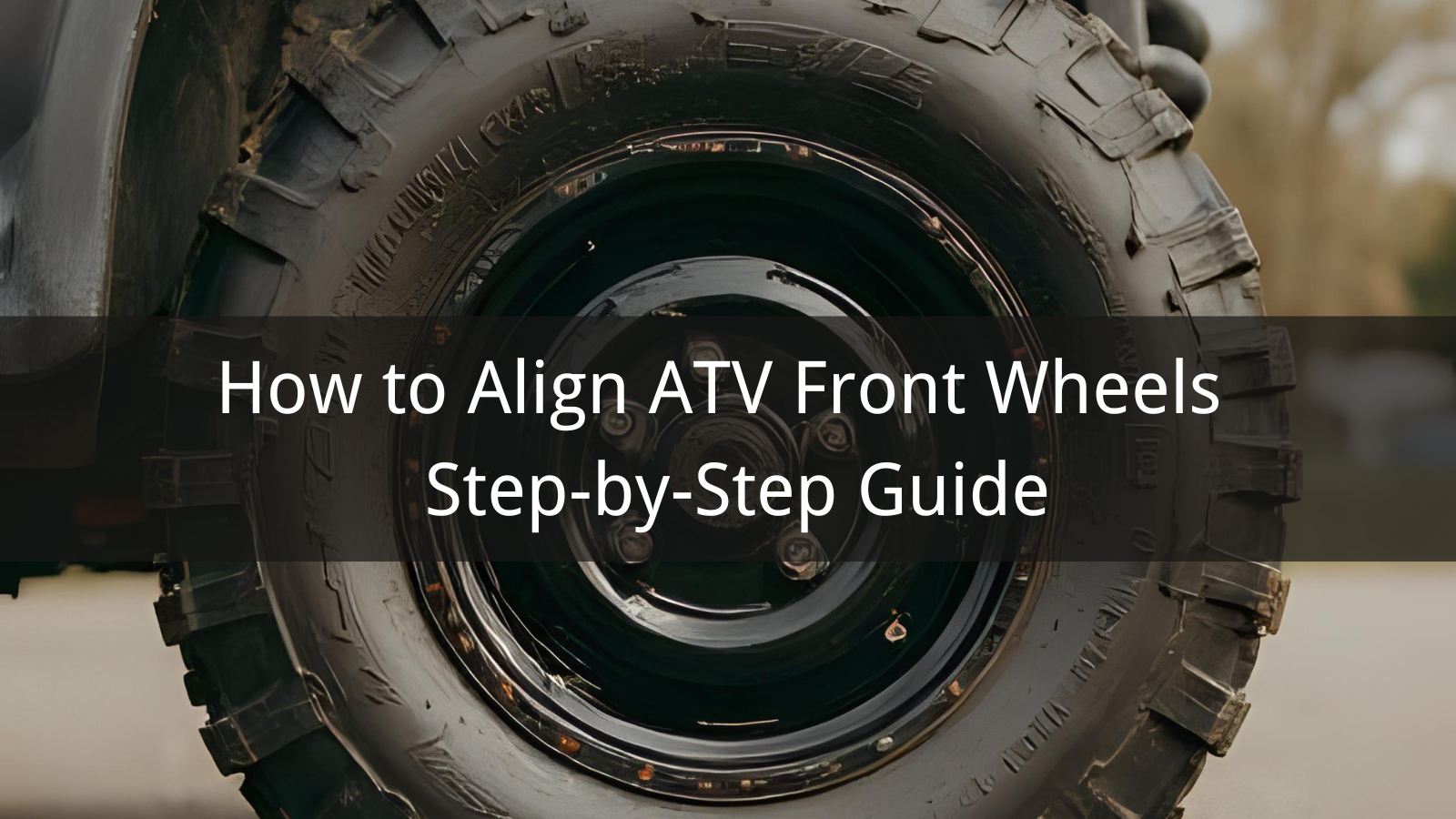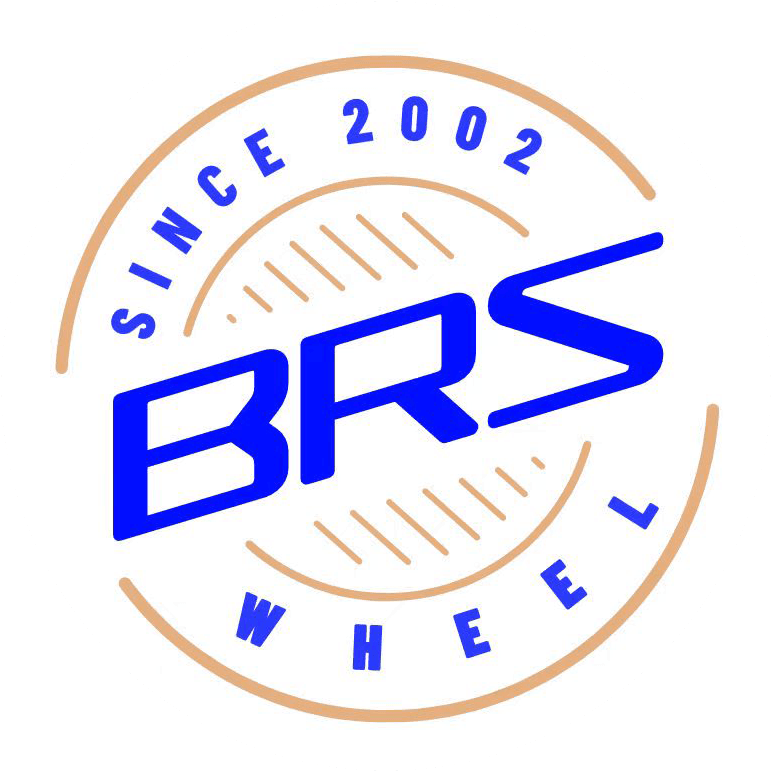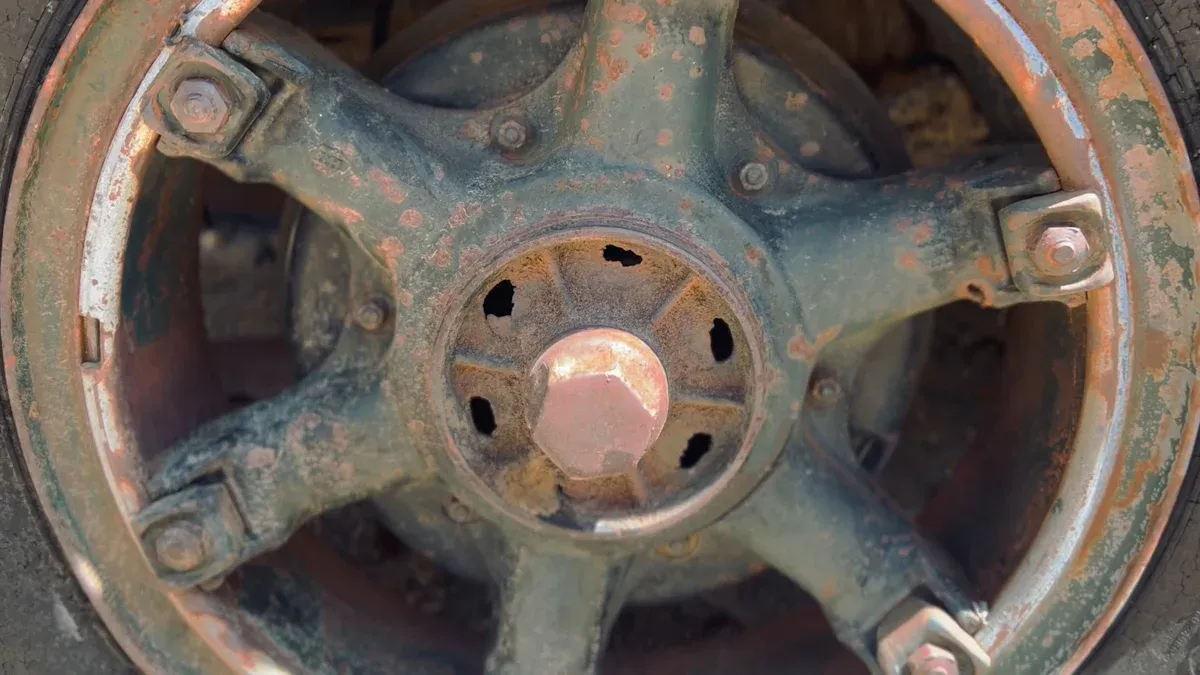
No, not all boat trailers have the same lug pattern. Picture this: someone grabs a shiny new rim, rushes to the trailer, and—whoops—the bolt holes refuse to line up. That moment feels like a bad joke. Knowing the lug pattern saves headaches and keeps things safe. BRS stocks boat trailer rims for every type of trailer, from classics to custom boat trailer wheels. Before buying, every boater should check the pattern for a smooth ride.
Key Takeaways for boat trailer rims
Not all boat trailers have the same lug pattern. You should always check before you buy new rims. Lug patterns change with trailer size and how much weight it can hold. More bolts give the trailer more strength. Different companies use their own lug patterns. Even trailers that look alike may need different rims. You must measure the bolt circle. This helps make sure the rim fits your trailer. Check your trailer rims often for rust and loose bolts. This keeps your trailer safe and working well. Galvanized rims do not rust easily. They are good for trailers used in saltwater. Use a tape measure to check lug patterns. Good measurements help you avoid buying the wrong rims. BRS has many rims for different lug patterns. This makes shopping easier for you.
Why Lug Patterns Vary
Boat Trailer’s Size and Capacity
Not all boat trailers are created equal. Some trailers haul tiny fishing boats, while others carry massive yachts. The size and weight of the boat decide how strong the trailer needs to be. Bigger boats need beefier trailers, and that means more bolts on the wheels. A small trailer might have just four bolts, perfect for a lightweight load of about 2,000 pounds. Step up to a five-bolt pattern, and the trailer can handle up to 3,500 pounds. Six bolts? Now the trailer can carry up to 5,200 pounds. The heavy hitters, with eight bolts, can haul up to 8,000 pounds. More bolts mean more strength, and that keeps the boat safe on the road.
Tip: Always match the number of bolts to the weight of your boat and trailer. Too few bolts can spell trouble on a bumpy road.
Manufacturer Differences
Every trailer brand wants to stand out. Some use unique designs or special features, and that includes the lug pattern. One company might use a 5 on 4.5-inch pattern, while another prefers 5 on 5-inch. Even trailers with the same number of bolts can have different distances between them. This keeps things interesting—and sometimes confusing—when shopping for new Boat Trailer Rims. Manufacturers pick patterns based on their own engineering, style, and sometimes just tradition. That’s why two trailers parked side by side might look the same but need totally different wheels.
Common bolt patterns include:
4 on 4 inch
5 on 4.5 inch
5 on 5 inch
6 on 5.5 inch
8 on 6.5 inch
Axle and Hub Design
The axle and hub are the heart of the trailer’s wheel system. They decide how the wheels attach and spin. If the hub has five studs, the rim needs five matching holes. The distance between these studs, called the bolt circle, must also match. Most four-lug hubs use a 4-inch circle, while five-lug hubs often use a 4.5-inch circle. If the pattern doesn’t match, the rim simply won’t fit. That’s why checking the axle and hub specs is so important. A mismatch can turn a simple tire change into a day-long headache.
Note: Industry standards help, but always double-check your trailer’s specs before buying new rims. BRS offers a wide range of rims to fit almost any pattern, so finding the right match is easier than ever.
No matter the size, brand, or design, every trailer needs the right lug pattern for safety and performance. That’s why BRS stocks Boat Trailer Rims for all kinds of trailers, from the smallest to the mightiest.
Common Lug Patterns
4-Lug
Four-lug patterns often show up on smaller boat trailers. These trailers usually carry lightweight boats, like a fishing skiff or a small dinghy. The 4-lug setup keeps things simple and light, making it easy to tow and maneuver. Most 4-lug wheels use a 4-inch bolt circle, which means the bolts form a perfect square. Spotting a 4-lug rim is easy—just count the bolts and look for that square shape.
Here’s a quick look at some standard 4-lug wheel sizes and uses:
Tire Size | Rim Type | Load Capacity |
|---|---|---|
4.80 x 12 | Galvanized 4 Lug Wheel | 990 lb |
Rim Diameter | Rim Width | Rim Finish | Tire Applications |
|---|---|---|---|
8″ | 3.75″ | Galvanized | 4.80×8 and 5.70×8 |
These wheels work best for trailers that don’t need to haul a heavy load. Galvanized rims help fight off rust, which is perfect for anyone who launches their boat in saltwater.
Tip: If you see a tiny trailer with four bolts on each wheel, you’re probably looking at a 4-lug pattern.
5-Lug (545, 550)
The 5-lug pattern rules the road for most standard boat trailers. It offers a great balance between strength and weight. Two main types exist: the 545 and the 550. The numbers tell you the diameter of the bolt circle in inches.
Pattern | Diameter (inches) | Common Trailer Types |
|---|---|---|
545 | 4.5 | Standard trailers |
550 | 5 | Heavier-duty trailers |
The 545 pattern, with a 4.5-inch circle, pops up everywhere. It’s the industry standard for most trailers. The 550 pattern, with a 5-inch circle, shows up on beefier models that need extra muscle. Both patterns use five bolts, but the distance between them makes all the difference.
The 545 pattern is the go-to for most trailers.
The 550 pattern fits special, heavy-duty models.
A quick count and a tape measure can help anyone spot the difference. Five bolts in a star shape? That’s a 5-lug. Just remember to check the distance between the bolts before picking out new Boat Trailer Rims.
6-Lug and 8-Lug
Six-lug and eight-lug patterns mean business. These setups belong to trailers that haul big boats or heavy loads. Six-lug wheels usually have a 5.5-inch bolt circle. Eight-lug wheels often use a 6.5-inch circle. Both patterns spread the weight across more bolts, which adds strength and stability.
Anyone who sees a trailer with six or eight bolts per wheel knows it’s built for serious towing. These patterns show up on trailers for large fishing boats, pontoons, or even small yachts. The extra bolts help prevent wheel failure when the trailer hits bumps or rough roads.
Note: More lugs mean more strength. Always match the lug pattern to the size and weight of the boat for a safe trip to the water.
Visual Identification
Spotting a lug pattern on a boat trailer rim feels like playing detective. Every wheel tells a story with its bolts. Some trailers show off a neat square, while others flash a star or a circle. Anyone can learn to recognize these patterns with a sharp eye and a little practice.
Here’s how to crack the code:
Count the Bolts
The first clue sits right in front. Four bolts mean a 4-lug pattern. Five bolts form a star, which signals a 5-lug pattern. Six bolts create a hexagon, and eight bolts line up in a circle. Counting always comes first.Look at the Shape
The arrangement of bolts gives away the pattern. Four bolts sit in a perfect square. Five bolts stretch into a star shape. Six bolts look like a honeycomb. Eight bolts form a circle that reminds people of a clock face.Check the Spacing
Not all patterns with the same number of bolts match up. The distance between bolts, called the bolt circle, changes everything. Some 5-lug wheels have bolts closer together, while others spread them out. A tape measure helps solve this mystery.
Tip:
Use a ruler or tape measure to check the distance from the center of one bolt to the center of the bolt directly across. This trick works best for even-numbered patterns. For odd-numbered patterns, measure from the center of one bolt to the edge of the bolt farthest away.
Quick Reference Table:
Lug Pattern | Bolt Arrangement | Common Shape | How to Spot |
|---|---|---|---|
4-Lug | 4 bolts | Square | Small trailers, bolts in a box |
5-Lug | 5 bolts | Star | Most trailers, bolts in a star |
6-Lug | 6 bolts | Hexagon | Heavy-duty, bolts in a honeycomb |
8-Lug | 8 bolts | Circle | Largest trailers, bolts like a clock |
Visual Clues:
🟦 4-Lug: Four bolts, square corners, often on tiny trailers.
⭐ 5-Lug: Five bolts, star shape, most common for mid-size trailers.
🟨 6-Lug: Six bolts, honeycomb look, built for strength.
🕗 8-Lug: Eight bolts, round like a clock, found on big rigs.
A boater who learns these clues can spot the right rim in seconds. No more guessing or mismatched wheels. The right pattern means a safe trip and a happy launch day.
Note:
BRS labels every rim with its lug pattern, making shopping easy. A quick glance at the wheel and the label saves time and trouble.
Visual identification turns a confusing chore into a simple task. With a little practice, anyone can become a trailer wheel expert. The next time someone stands in front of a trailer, they can count, look, and measure—then pick the perfect rim with confidence.
Identify Lug Pattern

Every boat owner faces the mystery of the lug pattern at some point. The right pattern means a smooth ride and a safe journey. The wrong one? That spells trouble. Here’s how anyone can crack the code and find the perfect fit for their trailer.
Count Lugs
Counting lugs sounds simple, but it’s the first and most important step. Each wheel has a set number of bolts, called lugs, that hold it in place. The number of lugs tells a lot about the trailer’s strength and what rims will fit.
Counting the lugs helps identify the correct bolt pattern.
The bolt pattern must match the trailer’s specs for the right rim.
Accurate counting and measurement keep the trailer safe and compatible.
A quick look at the wheel reveals the answer. Four bolts? That’s a 4-lug pattern. Five bolts? That’s a 5-lug. Six or eight bolts mean the trailer is ready for heavy lifting. Never guess—always count.
Measure Bolt Circle
After counting, the next step is measuring the bolt circle. This measurement unlocks the secret to the trailer’s pattern. The bolt circle is the diameter of the invisible circle that runs through the center of each lug hole. Getting this number right is crucial for picking the right Boat Trailer Rims.
Tools Needed
Tape measure or ruler (inches work best)
Pen and paper for notes
A friend (optional, but makes things easier)
Flashlight for dark corners
Step-by-Step Guide
Measuring the bolt circle feels like a science experiment, but anyone can do it. Here’s how:
Count the lugs on the wheel.
Four, five, six, or eight—each number has its own trick.For 4-lug wheels:
Place the tape measure at the center of one bolt hole. Skip one bolt hole. Measure to the center of the next hole. This gives the bolt circle diameter.For 5-lug wheels:
Start at the outer edge of one bolt hole. Measure to the center of the bolt hole most across from it, skipping one bolt in between. This method works because five bolts don’t line up perfectly across from each other.For 6-lug wheels:
Place the tape measure at the center of one bolt hole. Skip two bolt holes. Measure to the center of the next hole. This gives the diameter for six bolts.For 8-lug wheels:
Place the tape measure at the center of one bolt hole. Skip three bolt holes. Measure to the center of the next hole. This is the diameter for eight bolts.
🛠️ Pro Tip:
For even-numbered lugs, measure straight across from one bolt to the one directly opposite. For five-lug wheels, use the edge-to-center method for the most accurate result.
A bolt pattern like “5 on 4.5” means five bolts on a 4.5-inch circle. This number is the golden ticket for finding the right rim.
Check Manuals
Sometimes, the answer hides in plain sight. Manufacturer manuals often list the exact lug pattern for every trailer. These guides are reliable and save time.
Check the owner’s manual for the correct bolt pattern.
Look for markings stamped on the wheel itself.
Consult trusted automotive resources or databases for extra confirmation.
📚 Note:
Manuals rarely lie. Always double-check the pattern in the manual before buying new rims. When in doubt, ask a professional or reach out to a trusted supplier.
Identifying the lug pattern doesn’t require a degree in engineering. With a sharp eye, a tape measure, and a little patience, anyone can solve the puzzle. The right pattern means the right Boat Trailer Rims, and that means more time on the water and less time in the driveway.
Boat Trailer Rims Selection
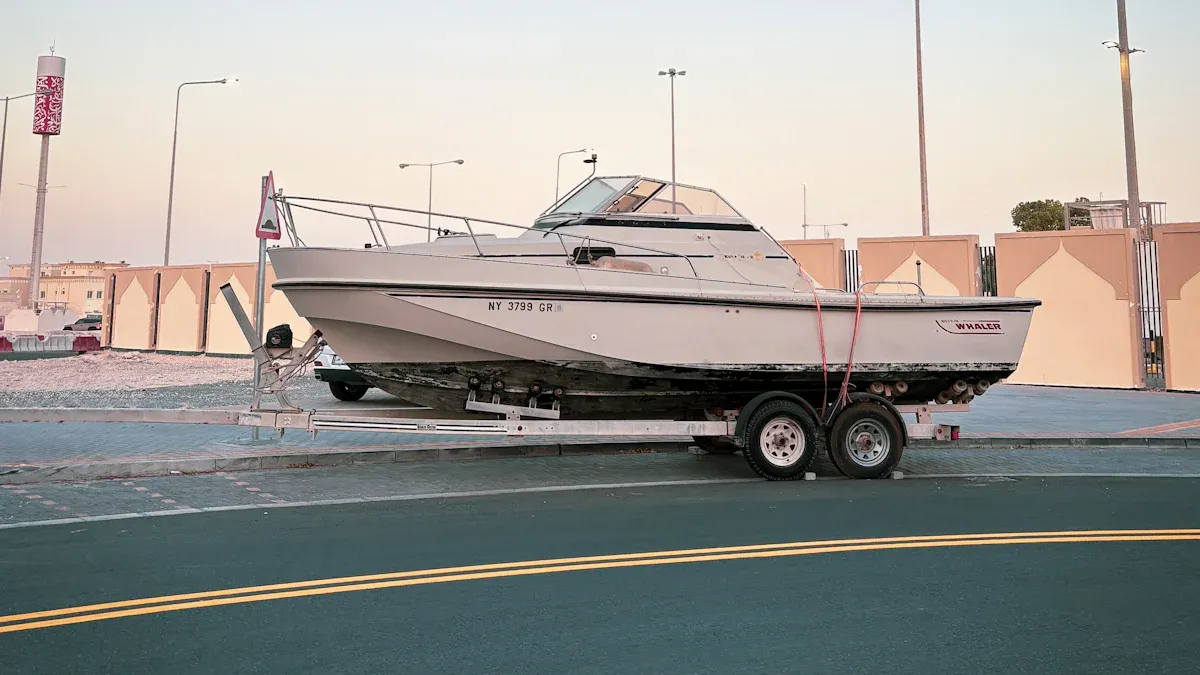
Material Options
Choosing the right rim material feels like picking a superhero for your trailer. Steel rims show up with muscle and toughness. They handle bumps and rough roads without breaking a sweat. Chrome wheels bring style to the party. They shine in the sun and make any trailer look sharp. Galvanized wheels laugh at saltwater and rain. They fight rust and keep rolling, even after a splashy boat launch. Painted wheels offer a splash of color and a layer of protection. Each type has its own strengths and quirks.
Material Type | Advantages | Disadvantages |
|---|---|---|
Steel Rims | Strength, affordability, suitable for various applications | Prone to rust if not maintained |
Chrome Wheels | Aesthetic appeal, enhances trailer look | Requires regular cleaning |
Galvanized Wheels | Excellent corrosion resistance, ideal for marine environments | Higher cost than standard steel rims |
Painted Wheels | Customization options, protective layer against rust | Requires regular maintenance |
Tip: Galvanized wheels win the battle against saltwater. Steel rims work best for freshwater adventures. Chrome wheels turn heads at the boat ramp.
Size and Fit Comes to Boat Trailer Rims
Size matters when it comes to Boat Trailer Rims. A rim that’s too small leaves the trailer wobbling. A rim that’s too big makes the ride bumpy. Every trailer has a perfect match. The right size keeps the boat steady and safe. Fit depends on the lug pattern and the bolt circle. A mismatched rim refuses to cooperate. The trailer manual holds the secret numbers. Measuring the old rim helps too. Smart boaters check the tire size, rim diameter, and bolt pattern before shopping.
Measure the rim diameter from edge to edge.
Count the lugs and check the bolt circle.
Match the rim width to the tire for a smooth ride.
Note: BRS offers rims in all shapes and sizes. They help boaters find the perfect fit for every trailer.
Custom and Standard Rims
Some trailers demand a custom touch. Others stick with standard rims. Custom Boat Trailer Rims solve tricky problems. They fit rare lug patterns and unique trailer designs. Standard rims work for most trailers. They follow industry rules and fit common bolt patterns. BRS stocks both types. Their custom rims handle special requests. Their standard rims cover the basics. Every boater finds what they need.
Custom rims fit odd patterns and special trailers.
Standard rims match most trailers on the road.
BRS helps boaters choose the right rim for every adventure.
🚤 Pro Tip: Custom rims save the day when standard options fall short. BRS makes finding the right rim easy, whether the trailer is classic or one-of-a-kind.
Boat Trailer Rims play a big role in every trip to the water. The right material, size, and fit keep the journey smooth. BRS stands ready with a wide selection, helping boaters roll out with confidence.
Match Rims and Lug Patterns
Safety
A mismatched rim on a boat trailer can turn a peaceful drive into a wild adventure. Wheels that do not fit right might wobble or even fall off. He watches his trailer bounce down the road, and suddenly, a tire rolls away like it’s in a race. That scene is not just embarrassing—it’s dangerous. The wrong lug pattern can cause uneven tire wear, making the trailer lean and sway. Drivers behind might swerve to avoid trouble. Handling gets tricky, and accidents can happen fast.
🚨 Safety Alert:
Mismatched rims and lug patterns can lead to:
Improper fitment, which increases the risk of wheel detachment.
Uneven tire wear, affecting trailer stability.
Compromised handling while towing, which may cause accidents.
Smart boaters always double-check their lug pattern before hitting the road. They know that matching rims and lug patterns keeps every trip safe and smooth.
Compatibility
Every trailer has its own personality. Some trailers like four bolts, others prefer five, six, or eight. When someone tries to fit the wrong rim, the bolts refuse to cooperate. The wheel sits crooked, and the trailer groans in protest. He measures, counts, and finally finds the perfect match. The right rim slides on easily, and the bolts tighten with a satisfying click.
A compatible rim means the trailer rolls straight and true. Tires wear evenly, and the boat stays secure. The journey to the water feels easy. Matching rims and lug patterns saves time, money, and frustration. No one wants to spend a sunny afternoon wrestling with stubborn wheels.
Legal and Warranty
Laws do not take mismatched wheels lightly. Some states require trailers to meet strict safety standards. If a rim does not fit the lug pattern, the trailer might fail inspection. He could face fines or even lose his registration. Warranties also depend on proper fit. Manufacturers want proof that the right parts are in place. If someone uses the wrong rim, the warranty might vanish like a boat in the fog.
📝 Note:
Matching rims and lug patterns is not just smart—it’s required for legal compliance and warranty protection.
BRS understands these challenges. Their team helps boaters find the right Boat Trailer Rims for every trailer. With a focus on quality and customer satisfaction, BRS makes sure every rim fits perfectly. Boaters trust BRS to keep their trailers safe, legal, and ready for adventure.
Uncommon Lug Patterns
Not every boat trailer fits the mold. Some roll into the parking lot with lug patterns that look like they belong in a museum. These rare setups can stump even the most seasoned boaters. When someone faces an oddball pattern, the search for the right rim turns into a treasure hunt.
Sourcing Rims
Finding rims for uncommon lug patterns feels like searching for buried gold. Most big-box stores carry only the usual suspects. The real gems hide in specialty shops and online catalogs. Boaters with rare trailers often turn to trusted sources that cater to unique needs. Here are some top places where rare rims might pop up:
Trailer Wheels
RecStuff.com
Reese
Tiedown Engineering
UFP by Dexter
Demco
Vision Wheel
Each of these suppliers stocks a variety of trailer wheels, including those hard-to-find patterns. BRS also stands out as a go-to for custom boat trailer rims. Their team understands that not every trailer fits the standard mold. They help boaters track down the perfect match, no matter how rare the pattern.
🕵️♂️ Tip:
Always double-check the bolt circle and lug count before ordering. A quick call or email to the supplier can save hours of frustration.
Using Adapters
Sometimes, the perfect rim just doesn’t exist for a rare pattern. That’s when adapters step in like superheroes. These clever devices let a trailer wear rims with a different lug pattern. Adapters bolt onto the existing hub, creating a new pattern for the rim to fit.
Install the adapter onto the hub using the correct torque. Tight bolts keep everything safe.
Check the lug nut torque regularly. A quick twist with a wrench keeps the wheels secure.
Many boaters report years of smooth sailing with adapters, as long as they keep up with maintenance.
Users trust adapters when installed and maintained properly. The non-drive nature of trailer wheels adds an extra layer of safety. Regular checks on lug nut torque keep worries at bay. For many, adapters turn a tricky problem into a simple fix.
⚙️ Note:
Adapters work best when installed by someone who knows their way around a wrench. Safety always comes first.
Professional Help
Some lug patterns play hard to get. When the numbers don’t add up or the rim refuses to fit, it’s time to call in the pros. Professionals measure lug patterns with precision tools. They spot mistakes before they happen and make sure the right parts end up on the trailer.
Seek help if the lug pattern looks confusing.
Call a pro when replacing a rim for a rare trailer.
Let experts handle the job to guarantee the right fit.
A quick visit to a trailer shop or a call to a custom rim provider like BRS can save the day. Their experience turns a puzzling problem into a smooth solution. Boaters who trust the experts spend less time scratching their heads and more time on the water.
🚤 Pro Tip:
When in doubt, let the professionals handle it. The right advice means the right rim—every time.
Maintenance Tips
Corrosion Prevention
Saltwater loves to attack metal. Boat trailer rims face a tough battle every time they splash into the ocean. He knows that rust creeps in when nobody pays attention. Smart boaters fight back with a few simple tricks.
He washes the trailer with soapy water after every salty adventure. This step removes hidden salt crystals.
She sprays moisture-displacing lubricants like WD-40 or CorrosionX on bolts and hinges. These sprays chase away water and keep rust at bay.
They swap out old fasteners for shiny stainless steel ones. Stainless steel laughs at rust.
He coats leaf springs with a thick layer of lubricating spray. Springs stay strong and flexible, even after a dunk in the bay.
🛡️ Tip: Galvanized rims from BRS stand up to saltwater like superheroes. They resist corrosion and keep rolling year after year.
Boaters who want extra protection follow a routine. First, they rinse the trailer with fresh water, making sure to hit the hubs and axles. Next, they grease wheel bearings at the start of every season. If rust shows up, they grab a wire brush and scrub it away, then spray on a rust inhibitor. These steps keep rims looking sharp and working hard.
Regular Checks
A trailer rim works best when someone checks it often. He walks around the trailer before every trip. She looks for loose bolts, cracks, or spots of rust. They spin the wheels and listen for strange noises. Regular checks catch problems early and prevent big disasters.
Quick Inspection Checklist:
Task | How Often | Why It Matters |
|---|---|---|
Wash with fresh water | After each use | Removes salt and dirt |
Inspect for rust | Monthly | Stops corrosion early |
Tighten lug nuts | Before trips | Prevents wheel loss |
Grease bearings | Seasonally | Keeps wheels spinning |
🔍 Note: A five-minute inspection saves hours of trouble. He never skips this step.
Boaters who check their rims often enjoy smooth rides and fewer surprises. A little attention goes a long way.
Regional Differences
Not every trailer rim faces the same challenges. He launches his boat in Florida, where saltwater rules the day. She fishes in Minnesota, where freshwater lakes sparkle. They travel across the country and notice that lug patterns change from place to place.
Some regions favor certain lug patterns. Southern states might use more galvanized rims because of salty air. Northern states stick with steel rims for freshwater adventures. Brands also play a role. One company loves the 5 on 4.5-inch pattern. Another prefers 6-lug setups for extra strength.
🌎 Tip: He checks local trailer shops for advice. She asks other boaters about common patterns in her area. They always match rims to the region and the brand.
Regional differences keep things interesting. Boaters who pay attention to local trends find rims that last longer and fit better. BRS offers rims for every region, every pattern, and every adventure.
Not all boat trailers share the same lug pattern, and that detail can make or break a smooth trip to the water. He should always count the lugs, measure the bolt circle, and match the pattern before picking new rims.
Count the number of lug bolts on each hub
Measure the bolt circle diameter for a perfect fit
Match the number of lugs and pattern for safety
BRS stands out as the go-to for custom-fit, durable boat trailer rims. They offer rims that meet every need, from load capacity to corrosion resistance.
Recommendation | Why It Matters |
|---|---|
Load Capacity | Keeps the trailer safe on the road |
Material Durability | Fights rust and lasts longer |
Proper Alignment | Ensures smooth, steady towing |
He can explore BRS’s selection or ask a pro for help. The right rim means more time on the water and fewer surprises on the road!
FAQ
What is a lug pattern?
A lug pattern shows how many bolts hold the wheel and how far apart they sit. He counts the bolts and measures the circle. This pattern decides which rim fits the trailer.
Can he use car rims on a boat trailer?
He should not use car rims on a boat trailer. Boat trailers need rims built for heavy loads and water. Car rims might not fit or last long near water.
How does she measure the bolt circle?
She grabs a tape measure. She measures from the center of one bolt to the center of the bolt across. For five bolts, she measures from the edge of one bolt to the center of the farthest bolt.
Why do some trailers have more lugs than others?
Big boats weigh more. Trailers for big boats need more lugs for strength. Eight lugs mean the trailer can carry a heavy load. Four lugs work for small boats.
What happens if they pick the wrong lug pattern?
The rim will not fit. The wheel might wobble or fall off. He could end up stranded at the boat ramp. Safety comes first—always match the lug pattern.
Does BRS offer rims for rare lug patterns?
BRS stocks rims for common and rare lug patterns. They help boaters find custom rims for unique trailers. He can call BRS for expert advice and a perfect fit.
Can she change the lug pattern with adapters?
She can use adapters to change the lug pattern. Adapters bolt onto the hub and create a new pattern. She should check with a pro before installing them.
Are galvanized rims better for saltwater?
Galvanized rims fight rust. He launches his boat in saltwater and trusts galvanized rims to last longer. These rims keep rolling after many salty adventures.
